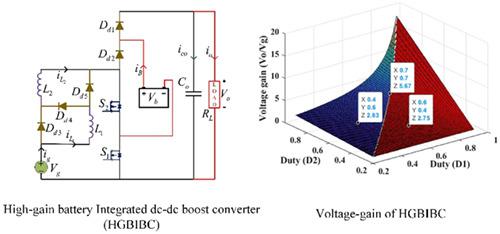当前位置:
X-MOL 学术
›
Int. J. Circ. Theory Appl.
›
论文详情
Our official English website, www.x-mol.net, welcomes your feedback! (Note: you will need to create a separate account there.)
Design and control of a reconfigurable high‐gain battery integrated dc‐dc boost converter for time‐varying loads
International Journal of Circuit Theory and Applications ( IF 2.3 ) Pub Date : 2020-10-15 , DOI: 10.1002/cta.2888 Anmol Ratna Saxena 1 , Deepak Kumar 1
International Journal of Circuit Theory and Applications ( IF 2.3 ) Pub Date : 2020-10-15 , DOI: 10.1002/cta.2888 Anmol Ratna Saxena 1 , Deepak Kumar 1
Affiliation

|
In this paper, a reconfigurable, low component count high‐gain battery integrated dc‐dc boost converter (HGBIBC) is proposed for power management of time‐varying loads (TVLs). The battery is integrated between the two switches and the two diodes, which provides an inherent feature of pulse‐charging and pulse‐discharging of the battery, thereby increasing its lifetime. The converter operation, in various modes, is explained, and the steady‐state and time‐domain analyses are performed to establish the high‐voltage gain feature of the converter, which makes it suitable for interfacing sources with low output voltages. The guidelines for the design of converter parameters and selection of switching devices are presented. Small‐signal models are derived, and the relative gain array (RGA) analysis is performed, which revealed that the control loops are of decoupled nature and hence the controllers, for each loop, can be designed independently, as in the case of a single‐input single‐output (SISO) converter. The PID controllers are designed to simultaneously regulate the load voltage and source current. The theoretical concepts developed in the paper are validated experimentally using the laboratory prototype of the converter. The experimental results, demonstrating power management, at load voltages of 60 and 48 V are presented, which are found to be in close correlation with the theoretical and simulation studies.
中文翻译:

用于时变负载的可重构高增益电池集成式DC-DC升压转换器的设计和控制
本文针对时变负载(TVL)的电源管理提出了一种可重构,低组件数,高增益电池集成式DC-DC升压转换器(HGBIBC)。电池集成在两个开关和两个二极管之间,提供了电池脉冲充电和脉冲放电的固有功能,从而延长了电池寿命。解释了各种模式下的转换器操作,并进行了稳态和时域分析,以建立转换器的高压增益功能,使其适用于连接低输出电压的电源。介绍了转换器参数设计和开关设备选择的指南。推导出小信号模型,并执行相对增益阵列(RGA)分析,这表明控制回路具有解耦性质,因此对于每个回路,控制器可以独立设计,例如在单输入单输出(SISO)转换器的情况下。PID控制器旨在同时调节负载电压和电源电流。本文中开发的理论概念已使用转换器的实验室原型进行了实验验证。给出了在60和48 V的负载电压下演示电源管理的实验结果,这些结果与理论和仿真研究密切相关。PID控制器旨在同时调节负载电压和电源电流。本文中开发的理论概念已使用转换器的实验室原型进行了实验验证。给出了在60和48 V的负载电压下演示电源管理的实验结果,这些结果与理论和仿真研究密切相关。PID控制器旨在同时调节负载电压和电源电流。本文中开发的理论概念已使用转换器的实验室原型进行了实验验证。给出了在60和48 V的负载电压下演示电源管理的实验结果,这些结果与理论和仿真研究密切相关。
更新日期:2020-10-15
中文翻译:

用于时变负载的可重构高增益电池集成式DC-DC升压转换器的设计和控制
本文针对时变负载(TVL)的电源管理提出了一种可重构,低组件数,高增益电池集成式DC-DC升压转换器(HGBIBC)。电池集成在两个开关和两个二极管之间,提供了电池脉冲充电和脉冲放电的固有功能,从而延长了电池寿命。解释了各种模式下的转换器操作,并进行了稳态和时域分析,以建立转换器的高压增益功能,使其适用于连接低输出电压的电源。介绍了转换器参数设计和开关设备选择的指南。推导出小信号模型,并执行相对增益阵列(RGA)分析,这表明控制回路具有解耦性质,因此对于每个回路,控制器可以独立设计,例如在单输入单输出(SISO)转换器的情况下。PID控制器旨在同时调节负载电压和电源电流。本文中开发的理论概念已使用转换器的实验室原型进行了实验验证。给出了在60和48 V的负载电压下演示电源管理的实验结果,这些结果与理论和仿真研究密切相关。PID控制器旨在同时调节负载电压和电源电流。本文中开发的理论概念已使用转换器的实验室原型进行了实验验证。给出了在60和48 V的负载电压下演示电源管理的实验结果,这些结果与理论和仿真研究密切相关。PID控制器旨在同时调节负载电压和电源电流。本文中开发的理论概念已使用转换器的实验室原型进行了实验验证。给出了在60和48 V的负载电压下演示电源管理的实验结果,这些结果与理论和仿真研究密切相关。


























 京公网安备 11010802027423号
京公网安备 11010802027423号